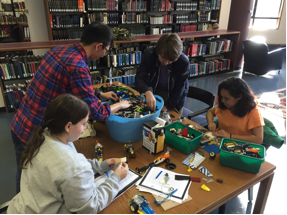Barbara Opar and Lucy Campbell, Column editors
Column by Megan Lotts, Art Librarian
Rutgers, the State University of New Jersey
One of the most interesting aspects of the Art Library Lego Playing Station is coming into the library each day to see what has transpired at the table. Some days it appears a group of grubby young children have been let loose at the table and Legos are strewn everywhere, including the floor. Other days I find elaborate models that tell stories about the students, their lives, their imaginations, and their dreams” (Lotts, 2015).
When I started the Art Library Lego playing Station in 2014 at the Rutgers University Art Library, located in the heart of New Brunswick, New Jersey, I was looking for ways to connect with the departments with whom I am a library liaison. I wanted to form deeper connections with the Landscape Architecture and Mason Gross Visual Arts, departments that are located a 15-30 minute walk from the Art Library. Coming from a background in Art & Design, I was concerned that these students did not know or understand the value that the library has to their education I also wanted to learn more about who the students, faculty, and staff are in these departments and how the library could best support these individuals.
Shortly after installing the Lego Playing Station, I contacted the Chair of the Landscape Architecture Department, Dr. Laura Lawson. After a brainstorming session we came up with an active learning assignment for her Environmental Design Analysis course that would incorporate the Art Library Lego Playing Station, and get her students into the library in person. The objective of the assignment was to introduce 100 incoming freshmen in the Landscape Architecture program to me (their library liaison), the Art Library Lego Playing Station, and the resources Rutgers University Libraries have to offer.
In September 2014, I was introduced to the EDA course and gave a 30-minute lecture that included a conceptual overview of the physical space of the art library, the resources available, an overview of the Art Library Research Guides, and an introduction to the Art Library Lego Playing Station (Lotts, 2015). Following my presentation Dr. Lawson introduced the assignment to the students and explained what would be required of them. Within days the Art Library Lego Playing Station saw an enormous increase in play and models made. Figure 1 shows 4 students working together to create a model for their assignment.
Figure 1 Students from Landscape Architecture EDA course. Photo credit: Megan Lotts
Since this collaboration with Dr. Lawson and her EDA course I have seen an increase in reference questions from the Landscape Architecture students and a decrease in my office candy supply. I have learned more about the needs of the LA department and now hold weekly office hours in the Blake Hall lobby, where the department resides. This gives students, faculty, and staff an opportunity to see me in person each week to ask questions or let me know anything new happening in their department. These hours also give me the opportunity to learn more about the individuals who are part of the LA community as well as share with them what is happening in the Rutgers University Libraries.
In conclusion, the Art Library Lego Playing Station has explored and expanded the conventional research functions of an academic library through encouraging creative problem-solving techniques associated with art and design and makerspaces (Lotts, 2015). If you would like to read a more about the Art Library Lego Playing station or an in depth version of this collaboration please read the paper, Playing with LEGO, Learning about the Library and ‘Making’ Campus Connections: The Rutgers Art Library Lego Playing Station, Part One, noted in the additional readings section.
Additional Readings:
Lotts, Megan. “On the Road, Playing with LEGO, and Learning about the Library: The Rutgers Art Library Lego Playing Station, Part Two.” Journal of Library Administration. Vol. 56, Iss.5 (Summer 2016).
Lotts, Megan. “Playing with LEGO, Learning about the Library and ‘Making’ Campus Connections: The Rutgers Art Library Lego Playing Station, Part One.” Journal of Library Administration Vol. 56, Iss.4 (Spring 2016).
Lotts, Megan. “Lego® Play: Implementing a Culture of Creativity & Making in the Academic Library.” ACRL Conference Proceedings, 409-418.
Top 4 Tips:
- When acquiring Legos, consider crowd-sourcing and asking for donations. This can be much cheaper and easier than purchasing the bricks from Lego, craigslist, ebay, or a garage sale.
- Create signage for your Lego Station and consider creating a comment box. You can also invite patrons to take pictures not Legos, to detour possible thefts.
- Find a good table or space where the Legos can be spread out and players have room to move. Remember Legos and players can be noisy so keep this in mind when locating your Legos.
- Find partners and co-collaborators. Think about who else might have interest in Legos or making things. Consider partnering with another course or organization within your campus or community.
Landscape Architecture Research Guide: http://libguides.rutgers.edu/landscapearchitecture
Rutgers Art Library Research Guide: http://libguides.rutgers.edu/artlibrary

 Study Architecture
Study Architecture  ProPEL
ProPEL 
